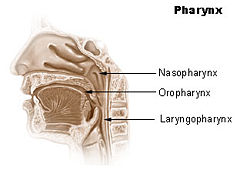Pharynx
| Pharynx | |
|---|---|
 |
|
| Head and neck. | |
 |
|
| Pharynx | |
| Gray's | subject #244 1141 |
| Artery | pharyngeal branches of ascending pharyngeal artery, ascending palatine, descending palatine, pharyngeal branches of inferior thyroid |
| Vein | pharyngeal veins |
| Nerve | pharyngeal plexus |
| MeSH | Pharynx |
| Dorlands/Elsevier | Pharynx |
The pharynx (plural: pharynges) is the part of the neck and throat situated immediately posterior to (behind) the mouth and nasal cavity, and cranial, or superior, to the oesophagus, larynx, and trachea.
Contents |
Functions
It was part of the digestive system and respiratory system of many organisms.
Because both food and air pass through the pharynx, a flap of connective tissue called the epiglottis closes over the trachea when food is swallowed to prevent choking or aspiration. In humans the pharynx is important in vocalization.
In persons with hayfever, oral allergy syndrome and related allergies, the pharynx is often a reaction site to allergens, with common symptoms including burning and itching.
Parts
The human pharynx is conventionally divided into three sections:
Oropharynx
The oropharynx lies behind the oral cavity. The anterior wall consists of the base of the tongue and the vallecula; the lateral wall is made up of the tonsil, tonsillar fossa, and tonsillar (faucial) pillars; the superior wall consists of the inferior surface of the soft palate and the uvula.
Nasopharynx
The nasopharynx lies behind the nasal cavity.
Postero-superiorly this extends from the level of the junction of the hard and soft palates to the base of skull, laterally to include the fossa of Rosenmuller.
The inferior wall consists of the superior surface of the soft palate.
Laryngopharynx
The laryngopharynx, also known as the hypopharynx, roughly corresponds to the levels between C4 to C6, it includes the pharyngo-esophageal junction (postcricoid area), the piriform sinus, and the posterior pharyngeal wall.
Like the oropharynx above it the hypopharynx serves as a passageway for food and air and is lined with a stratified squamous epithelium.
It lies inferior to the upright epiglottis and extends to the larynx, where the respiratory and digestive pathways diverge.
At that point, the laryngopharynx is continuous with the esophagus posteriorly. The esophagus conducts food and fluids to the stomach; air enters the larynx anteriorly. During swallowing, food has the "right of way", and air passage temporarily stops.
Additional images
References
- Stedman's/LWW 1551471
- Human Anatomy and Physiology Elaine N. Marieb and Katja Hoehn, Seventh Edition.
- TNM Classification of Malignant Tumours Sobin LH & Wittekind Ch (eds)Sixth edition UICC 2002 ISBN 0-471-22288-7
See also
External links
- SUNY Labs 31:st-1401
|
||||||||
|
||||||||||||||||||||||||